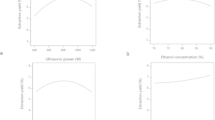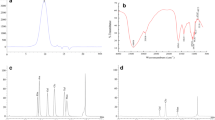Abstract
In order to effectively prepare useful components from Sargassum coreanum, enzyme-assisted extraction was adapted to extraction processing of the seaweed. Our previous studies have shown that Neutrase extract of S. coreanum exhibited the strongest antioxidant activities among ten enzymatic extracts. It is reported that many antioxidant substances have anticancer or anticarcinogenic properties. Thus, Neutrase extract, which possessed a strong antioxidant activity in the previous study, was separated into four different molecular weight fractions (<5, 5–10, 10–30, and >30 kDa) which were screened for inhibitory activities against cancer cell growth. The >30-kDa fraction inhibited cell growth more than the other fractions. We separated crude polysaccharide (CPS) from the >30-kDa fraction to show that CPS increased DNA fragmentation, apoptotic body, and apoptotic cells with hypodiploid DNA contents in HL-60 cells. This indicates that CPS suppressed the growth of cells through apoptosis. The CPS gradually increased the expression of pro-apoptotic Bax and led to the activation of caspase-3 and cleavage of poly(ADP-ribose) polymerase. The CPS was 40.85% fucose, 27.24% galactose, and 12.99% glucose, as analyzed by bio-liquid chromatography. These findings suggest that apoptosis effect can be mediated by CPS in HL-60 cells.





Similar content being viewed by others
References
Ahn G, Park E, Kim DS, Jeon YJ, Shin T, Park JW, Woo HC, Lee KW, Jee Y (2008) Anti inflammatory effects of enzymatic extract from Ecklonia cava on TPA-induced ear skin edema. Food Sci Biotechnol 17:745–750
AOAC (1990) Official method of analysis of the association of official analytical chemists, 15th edn. Association of Official Analytical Chemist Inc., Washington
Athukorala Y, Jung WK, Vasanthan T, Jeon YJ (2006) An anticoagulative polysaccharides from an enzymatic hydrolysate of Ecklonia cava. Carbohydr Polym 66:184–191
Athukorala Y, Ahn GN, Jee YH, Kim GY, Kim SH, Ha JH, Kang JS, Lee KW, Jeon YJ (2009) Antiproliferative activity of sulfated polysaccharides isolated from an enzymatic digest of Ecklonia cava on the U-937 cell line. J Appl Phycol 21:307–314
Brady HJM, Gil-Gomez G (1998) Molecules in focus Bax. The pro-apoptotic Bcl-2 family member, Bax. Int J Biochem Cell Biol 30:647–650
Brink A, Schulz B, Kobras K, Lutz WK, Stopper H (2006) Time-dependent effects of sodium arsenite on DNA breakage and apoptosis observed in the comet assay. Mutat Res Genet Toxicol Environ 603:121–128
Cha MR, Kim JY, Hwang JH, Kim SL, Chung IM (2007) Induction of cytotoxicity and apoptosis in HT-29 human colon carcinoma cells by a gleditsiae semen extract. Food Sci Biotechnol 16:260–264
Chandler SF, Dodds JH (1983) The effect of phosphate, nitrogen and sucrose on the production of phenolics and solasidine in callus cultures of Solanum laciniatum. Plant Cell Rep 2:105–110
Chen YC, Lin-Shiau SY, Lin JK (1998) Involvement of reactive oxygen species and caspase 3 activation in arsenite-induced apoptosis. J Cell Physiol 177:324–333
Cheung AC, Huang TC, Lai CS, Pan MH (2005) Induction of apoptosis by luteolin through cleavage of Bcl-2 family in human leukemia HL-60 cells. Eur J Pharmacol 509:1–10
Cumashi A, Ushakova NA, Preobrazhenskaya ME, D’Incecco A, Piccoli A, Totani L, Tinari N, Morozevich GE, Berman AE, Bilan MI, Usov AI, Ustyuzhanina NE, Grachev AA, Sanderson CJ, Kelly M, Rabinovich GA, Iacobelli S, Nifantiev NE (2007) A comparative study of the anti-inflammatory, anticoagulant, antiangiogenic, and antiadhesive activities of nine different fucoidans from brown seaweeds. Glycobiology 17:541–552
Fernandes-Alnemri T, Litwack G, Alnemri ES (1994) CPP32, a novel human apoptotic protein with homology to Caenorhabditis elegans cell death protein Ced-3 and mammalian interleukin-1 beta-converting enzyme. J Biol Chem 269:30761–30764
Gonzalez AG, Darias V, Estevez E (1982) Chemo-therapeutic activity of polyhalogenated terpenes from Spanish algae. Planta Med 44:44–46
Gschwind M, Huber G (1995) Apoptotic cell death induced by b-amyloid 1–42 peptide is cell type dependent. J Neurochem 65:292–300
Guven KC, Ozsoy Y, Ulutin ON (1991) Anticoagulant, fibrinolytic, and antiaggregant activity of carrageenans and alginic acid. Bot Mar 34:429–432
Guzman S, Gato A, Lamela M, Freire-Garabal M, Calleja JM (2003) Anti-inflammatory and immunomodulatory activities of polysaccharides from Chlorella stigmatophora to Phaeodactylum tricornutum. Phytother Res 17:665–670
Harada H, Kamei Y (1997) Selective cytotoxicity of marine algae extracts to several human leukemic cell lines. Cytotechnology 25:213–219
Hartmann A, Speit G (1997) The contribution of cytotoxicity to DNA-effects in the single cell gel test (comet assay). Toxicol Lett 90:133–138
Hengeartner MO (2000) The biochemistry of apoptosis. Nature 407:770–776
Heo SJ, Jeon YJ, Lee JH, Kim HT, Lee KW (2003) Antioxidant effect of enzymatic hydrolyzate from a kelp, Ecklonia cava. Algae 18:341–347
Herzig MCS, Trevino AV, Liang H, Salinas R, Waters SJ, MacDonald JR, Woynarowska BA, Woynarowski JM (2006) Apoptosis induction by the dual-action DNA- and protein-reactive antitumor drug irofulven is largely Bcl-2-independent. Biochem Pharmacol 65:503–513
Hockenbery DM, Oltvai ZN, Yin XM, Milliman CL, Korsmeyer SJ (1993) Bcl-2 function in an antioxidant pathway to prevent apoptosis. Cell 75:241–251
Iguchi K, Usami Y, Hirano K, Hamatake M, Shibata M, Ishida R (1999) Decreased thymosin β4 in apoptosis induced by a variety of antitumor drug. Biochem Pharmacol 57:1105–1111
Jeon YJ, Byun HG, Kim SK (2000) Improvement of functional properties of cod frame protein hydrolysates using ultrafiltration membranes. Process Biochem 35:471–478
Ju EM, Lee SE, Hwang HJ, Kim JH (2004) Antioxidant and anticancer activity of extract from Betula platyphylla var. japonica. Life Sci 74:1013–1026
Kashiwagi M, Mynderse JS, Moore RE, Norton TR (1980) Antineoplastic evaluation of Pacific basin marine algae. J Pharm Sci 69:735–738
Kaufmann S, Hengartner MO (2001) Programmed cell death: alive and well in the new millennium. Trends Genet 11:526–534
Kerr JF, Wyllie AH, Currie AR (1972) Apoptosis: a basic biological phenomenon with wide-ranging implications in tissue kinetics. Br J Cancer 26:239–257
Kim SH, Choi DS, Athukorala Y, Jeon YJ, SenevirathneM RCK (2007) Antioxidant activity of sulfated polysaccharides isolated from Sargassum fulvellum. J Food Sci Nutr 12:65–73
Kim EK, Lee SJ, Lim BO, Jeon YJ, Song MD, Park TK, Lee KH, Kim B, Lee SR, Moon SH, Jeon BT, Park PJ (2008a) Antioxidative and neuroprotective effects if enzymatic extracts from leaves of Perilla frutescens var. japonica. Food Sci Biotechnol 17:279–286
Kim KN, Kim SH, Kim WS, Kang SM, Lee KW, Lee WJ, Park SY, Kim SK, Jeon YJ (2008b) Antitumor activities of sea staghorn (Codium fragile) against CT-26 cells. Food Sci Biotechnol 17:976–982
Ko SC, Kang SM, Ahn G, Yang HP, Kim KN, Jeon YJ (2010a) Antioxidant activity of enzymatic extracts from Sargassum coreanum. J Korea Soc Food Sci Nutr 39:494–499
Ko SC, Kang SM, Lee SH, Ahn G, Kim KN, Kim YT, Kim JS, Heu MS, Jeon YJ (2010b) Protective effect of enzymatic extracts from Sargassum coreanum on H2O2-induced cell damage. Fish Aquat Sci 13:26–35
Kong CS, Kim JA, Yoon NA, Kim SK (2009) Induction of apoptosis by phloroglucinol derivative from Ecklonia cava in MCF-7 human breast cancer cells. Food Chem Toxicol 47:1653–1658
Kosovel V, Avanzini A, Scarcia V, Furlani A (1998) Algae as possible sources of antitumoral agents. Preliminary evaluation of the in vitro cytostatic activity of crude extracts. Pharmacol Res Commun 20:27–31
Lee SH, Heo SJ, Hwang JY, Han JS, Jeon YJ (2010) Protective effects of enzymatic digest from Ecklonia cava against high glucose-induced oxidative stress in human umbilical vein endothelial cells. J Sci Food Agric 90:349–356
Li P, Zhou LB, Jin XD, He J, Dai ZY, Zhou GM, Gao QX, Li S, Li Q (2008) Assessment of DNA damage of Lewis lung carcinoma cells irradiated by carbon ions and X-rays using alkaline comet assay. Nucl Instrum Meth B 266:262–266
Lizard G, Fournel S, Genestier L, Dhedin N, Chaput C, Flacher M (1995) Kinetics of plasma membrane and mitochondrial alterations in the cells undergoing apoptosis. Cytometry 21:275–283
Lu KH, Lue KH, Liao LKL, Chung JG (2005) Induction of caspase-3-dependent apoptosis in human leukemia HL-60 cells by paclitaxel. Clin Chim Acta 357:65–73
Matsuda M, Yamori T, Naito M, Okutani K (2003) Structural revision of sulfated polysaccharides B-1 isolated from a marine pseudomonas species to its cytotoxic activity against human cancer cell lines. Mar Biotechnol 5:13–19
Mosmann T (1983) Rapid colorimetric assay for cellular growth and survival: application to proliferation and cytotoxicity assays. J Immunol Meth 65:55–63
Nara T, Kamei Y, Tsubouchi A, Annoura T, Hirota K, Iizumi K, Dohmoto Y, Ono T, Aki T (2005) Inhibitory action of marine algae extracts on the Trypanosoma cruzi dihydrooroate dehydrogenase activity and on the protozoan growth in mammalian cells. Parasitol Int 54:59–64
Nicoletti I, Migliorati G, Pagliacci MC, Grignani F, Riccardi C (1991) A rapid and simple method for measuring thymocyte apoptosis by propidium iodide staining and flow cytometry. J Immunol Meth 139:271–279
Park PJ, Heo SJ, Park EJ, Kim SK, Byun HG, Jeon BT, Jeon YJ (2005) Reactive oxygen scavenging effect of enzymatic extract from Sargassum thunbergii. J Agric Food Chem 53:6666–6672
Sen S, D’Incalci M (1992) Apoptosis. Biochemical events and relevance to cancer chemotherapy. FEBS Lett 307:122–127
Singh NP (2000) Microgels for estimation of DNA strand breaks, DNA protein cross links and apoptosis. Mutat Res 455:111–127
Siriwardhana N, Jeon YJ, Kim SH, Ha JH, Heo SJ, Lee KW (2005) Enzymatic hydrolysis for effective extraction of antioxidative compounds from Hizikia fusiformis. Algae 19:59–68
Staub AM (1965) Removal of protein—Sevag method. Meth Carbohyd Chem 5:5–6
Thompson CB (1995) Apoptosis in the pathogenesis and treatment of disease. Science 267:1456–1462
Umemura K, Yanase K, Suzuki M, Okutani K, Yamori T, Andoh T (2003) Inhibition of DNA topoisomerases I and II, and growth inhibition of human cancer cell lines by marine microalgal polysaccharide. Biochem Pharmacol 66:481–487
Wang XW, Zhan Q, Coursen JD, Khan MA, Kontny HU, Yu L (1999) GADD45 induction of a G2/M cell cycle checkpoint. Proc Natl Acad Sci USA 96:3706–3711
Zhang Q, Li N, Zhou G, Lu X, Xu Z, Li Z (2003) In vivo antioxidant activity of polysaccharide fraction from Porphyra haitanesis (Rhpdephyta) in aging mice. Pharmacol Res 48:151–155
Acknowledgment
This research was supported by a grant from the Jeju National University fund, Korea.
Author information
Authors and Affiliations
Corresponding author
Rights and permissions
About this article
Cite this article
Ko, SC., Lee, SH., Ahn, G. et al. Effect of enzyme-assisted extract of Sargassum coreanum on induction of apoptosis in HL-60 tumor cells. J Appl Phycol 24, 675–684 (2012). https://doi.org/10.1007/s10811-011-9685-0
Received:
Revised:
Accepted:
Published:
Issue Date:
DOI: https://doi.org/10.1007/s10811-011-9685-0




